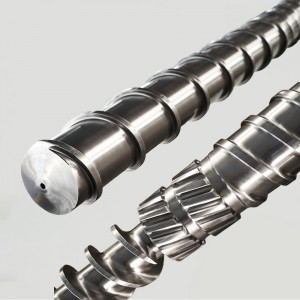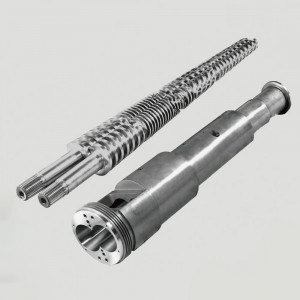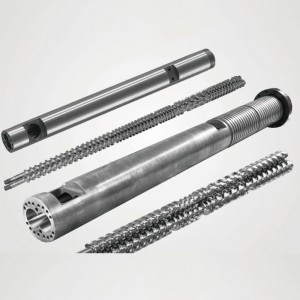
The Bottle Blow Molding Screw Barrel plays a pivotal role in ensuring the efficient melting and homogenization of plastic materials during production. Proactive care, such as real-time condition monitoring, guarantees consistent machine performance. This consistency minimizes defects and waste, enhancing overall production quality. Blowing Screw Barrel Factories emphasize regular maintenance to preserve the equipment’s durability and precision. Additionally, the integration of a Vented Single Screw Extruder can further optimize the process, while the use of a Plastic Machine Screw Barrel ensures that the materials are processed with the highest efficiency.
Causes of Damage to Bottle Blow Molding Screw Barrel

Improper Material Selection
Selecting the wrong materials for the blow molding process can significantly impact the performance and lifespan of the Bottle Blow molding screw barrel. Materials with abrasive additives, such as calcium carbonate or glass fibers, can cause excessive wear on the screw and barrel surfaces. This abrasion occurs when hard particles grind against the components under high temperatures and pressure. Additionally, corrosive materials or chemicals in the polymer can react with the screw and barrel, leading to material degradation over time. Manufacturers must carefully evaluate the compatibility of raw materials with the screw barrel to prevent these issues. Using high-quality, non-abrasive, and non-corrosive materials ensures the equipment remains durable and efficient.
Overheating and Thermal Stress
Excessive heat and thermal stress can damage the screw barrel by weakening its structural integrity. The Bottle Blow molding screw barrel operates under high temperatures to melt and homogenize plastic materials. However, improper temperature settings or prolonged exposure to extreme heat can cause warping or cracking. Uneven heating within the barrel can also lead to thermal stress, which compromises the precision of the molding process. To mitigate these risks, manufacturers should monitor and optimize temperature settings across all heating zones. Advanced temperature control systems can help maintain consistent heat distribution, reducing the likelihood of thermal damage.
Poor Operational Practices
Operational errors often contribute to the premature wear and tear of the screw barrel. Inconsistent machine settings, such as incorrect pressure or rotation speed, can place undue stress on the components. Additionally, inadequate cleaning routines allow residue to build up inside the barrel, leading to adhesion-related wear. Over time, this buildup can obstruct the flow of materials and reduce the efficiency of the molding process. Operators must follow standardized procedures to ensure proper machine operation. Regular training programs can equip operators with the knowledge to handle the equipment correctly, minimizing the risk of damage.
Tip: A proactive approach to identifying and addressing operational inefficiencies can significantly extend the lifespan of the screw barrel.
Common Causes of Damage: A Quick Overview
The table below summarizes the primary causes of damage to the Bottle Blow molding screw barrel:
| Cause | Description |
|---|---|
| Abrasion | Caused by hard additives or particles in the polymer, such as calcium carbonate and glass fibers, which wear against the screw under high temperatures and pressure. |
| Corrosion | Results from chemical reactions between the materials and the environment, leading to material degradation. |
| Adhesion | Occurs when materials stick to the screw and barrel surfaces, causing wear over time. |
By understanding these causes, manufacturers can implement targeted strategies to protect their equipment and maintain production efficiency.
Preventive Measures for Screw Barrel Protection

Use High-Quality and Compatible Materials
Selecting high-quality and compatible materials is essential for preserving the integrity of the Bottle Blow molding screw barrel. Manufacturers should prioritize materials that align with industry standards and undergo rigorous compatibility testing. For instance, maintaining specific parameters such as a melt temperature of 260–275 °C and a blowing pressure of 30 bar ensures optimal performance.
| Parameter | Value |
|---|---|
| Melt Temperature | 260–275 °C |
| Injection Speed | 150 mm/s |
| Cooling Time | 30 s |
| Mould Temperature | 12 °C |
| Holding Pressure | 80 bar |
| Preheating Temperature | 110 °C |
| Blowing Pressure | 30 bar |
| Water Content | 74 ppm |
| ISO Standard for Water | ISO 15512:2019 (E) |
| ISO Standard for Specimens | ISO 294-1:2017 (E) |
Additionally, using closures and bottles from the same supplier minimizes the risk of material incompatibility. Ensuring that bottle necks and closure threads are designed to function together prevents leakage and reduces wear on the screw barrel. These measures not only protect the equipment but also enhance production efficiency.
Optimize Machine Settings for Temperature and Pressure
Properly calibrated machine settings play a critical role in extending the lifespan of the Bottle Blow molding screw barrel. Excessive heat or pressure can lead to thermal stress, warping, or cracking. Manufacturers should implement advanced temperature control systems to maintain consistent heat distribution across all zones.
Tip: Regularly monitor and adjust settings such as injection speed, holding pressure, and cooling time to ensure optimal performance.
Investing in modern equipment, such as premium efficiency motors in hydraulic machines, further supports energy management and cost savings. This focus on sustainability reduces operational costs while maintaining the durability of the screw barrel. Lightweight designs in blow molding machinery also contribute to improved efficiency, making these adjustments both practical and economical.
Train Operators on Proper Usage Techniques
Operator training is a cornerstone of preventive maintenance. Proper handling of the Bottle Blow molding screw barrel minimizes operational errors that could lead to premature wear. Training programs should emphasize:
- The importance of maintaining consistent machine settings.
- Techniques for thorough cleaning to prevent residue buildup.
- Recognizing early warning signs of wear, such as unusual noises or reduced efficiency.
Note: Well-trained operators can identify and address inefficiencies before they escalate, ensuring uninterrupted production and reducing downtime.
By equipping operators with the necessary skills, manufacturers can safeguard their equipment and maintain high production standards. This proactive approach not only extends the lifespan of the screw barrel but also enhances overall operational efficiency.
Maintenance and Early Warning Signs
Regular Cleaning and Maintenance Routines
Routine cleaning and maintenance are essential for preserving the Bottle Blow Molding Screw Barrel’s efficiency and durability. Manufacturers should implement preventive maintenance programs to identify early signs of wear and address them promptly.
- Conduct regular inspections to detect corrosive or abrasive wear.
- Measure screws and barrels frequently to assess their condition.
- Rebuild or replace components showing signs of wear, as even minor damage can affect production quality.
- Monitor the impact of resins on equipment to ensure consistent output and part quality.
Operators should avoid using powered wire brushes during cleaning to prevent surface damage. Instead, they should follow responsible shutdown procedures, such as reducing heat levels and purging at low RPM, to minimize oxidation risks. Maintaining calibrated temperature controllers and ensuring the barrel cooling system functions correctly further prevents overheating and extends the equipment’s lifespan.
Tip: Keeping an output test log helps track screw and barrel performance over time, enabling early detection of inefficiencies.
Inspect for Wear, Tear, and Residue Buildup
Frequent inspections allow manufacturers to identify wear, tear, and residue buildup before they escalate into major issues. Abrasive materials and residue can obstruct material flow, reducing production efficiency.
Operators should examine the screw and barrel surfaces for signs of abrasion or corrosion. Residue buildup inside the barrel should be removed using safe cleaning methods to prevent adhesion-related wear. Regularly monitoring the equipment ensures that any damage is addressed promptly, maintaining optimal performance.
Address Warning Signs Like Unusual Noises or Reduced Efficiency
Unusual noises or reduced efficiency often indicate underlying issues with the screw barrel. These warning signs should never be ignored, as they can lead to costly downtime or equipment failure.
Operators should investigate the source of unusual sounds, which may result from misaligned components or excessive wear. Reduced efficiency, such as slower material flow or inconsistent output, often signals residue buildup or damage to the screw barrel. Addressing these issues immediately prevents further damage and ensures uninterrupted production.
Note: Early intervention minimizes repair costs and extends the lifespan of the equipment, safeguarding production quality.
Proactively maintaining the Bottle Blow Molding Screw Barrel ensures consistent production quality and reduces long-term costs. Regular inspections, proper lubrication, and adherence to maintenance schedules prevent costly breakdowns.
| Maintenance Practice | Key Benefit |
|---|---|
| Inspecting seals, valves, and connections | Prevents leaks and ensures smooth operation |
| Lubricating moving parts | Reduces wear and extends lifespan |
| Following a preventive maintenance schedule | Minimizes downtime and avoids breakdowns |
Investing in care today safeguards efficiency tomorrow.
FAQ
What is the primary function of the Bottle Blow molding screw barrel?
The Bottle Blow molding screw barrel melts, mixes, and homogenizes plastic materials, ensuring consistent quality during the blow molding process.
How often should the screw barrel undergo maintenance?
Manufacturers should perform routine maintenance every 500-1,000 operational hours to prevent wear and ensure optimal performance.
What are the signs of a damaged screw barrel?
Signs include unusual noises, reduced efficiency, uneven material flow, or visible wear on the screw and barrel surfaces.
Post time: May-21-2025
